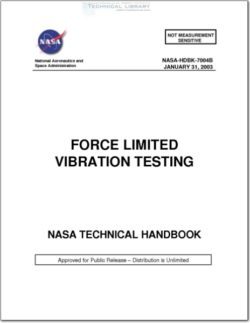NASA-HDBK-7004B

- Version
- 274 Downloads
- 971.52 KB File Size
- 1 File Count
- April 19, 2016 Create Date
- April 19, 2016 Last Updated
Force Limited Vibration Testing

FOREWORD
This handbook is approved for use by NASA Headquarters and all Centers and is intended to
provide a common framework for consistent practices across NASA programs. This first
revision of the handbook includes force data measured in two flight experiments and a few
minor editorial changes. The flight data provide validation of the force limiting methodology.
The primary goal of vibration tests of aerospace hardware is to identify problems that, if not
remedied, would result in flight failures. This goal can only be met by implementing a realistic
(flight-like) test with a specified positive margin. In most cases, the goal is not well served by
traditional acceleration-controlled vibration tests that indeed screen out flight failures, but in
addition may cause failures that would not occur in flight. The penalty of over testing is
manifested in design and performance compromises, as well as in the high costs and
schedule overruns associated with recovering from artificial test failures.
It has been known for 30 years that the major cause of over testing in aerospace vibration
tests is associated with the infinite mechanical impedance of the shaker and the standard
practice of controlling the input acceleration to the frequency envelope of the flight data. This
approach results in artificially high shaker forces and responses at the resonance frequencies
of the test item. To alleviate this problem it has become common practice to limit the
acceleration responses in the test to those predicted for flight, but this approach is very
dependent on the analysis that the test is supposed to validate. Another difficulty with
response limiting is that it requires placing accelerometers on the test item at many critical
locations, some of which are often inaccessible.
The advent of piezoelectric triaxial force gages has made possible an alternative, improved
vibration-testing approach based on measuring and limiting the reaction force between the
shaker and test item. Piezoelectric force gages are robust, relatively easy to install between
the test item and shaker, and require the same signal conditioning as piezoelectric
accelerometers commonly used in vibration testing. Also vibration test controllers now provide
the capability to limit the measured forces and thereby notch the input acceleration in real
time. To take advantage of this new capability to measure and control shaker force, a
rationale for predicting the flight-limit forces has been developed, validated with flight
measurements, and applied to many flight projects during the past five years. Force limited
vibration tests are conducted routinely at the Jet Propulsion Laboratory (JPL) and also at
several other NASA Centers, Government laboratories, and many aerospace contractors.
This handbook describes an approach that may be used to facilitate and maximize the
benefits of applying this relatively new technology throughout NASA in a consistent manner. A
NASA monograph, NASA-RP-1403, which provides more detailed information on the same
subject, is also available for reference.
NASA-HDBK—7004B
January 31, 2003
Requests for information, corrections, or additions to this handbook should be directed to the
Mechanical Systems Engineering and Research Division, Section 352, Jet Propulsion
Laboratory, 4800 Oak Grove Dr., Pasadena, CA 91109. Requests for general information
concerning standards should be sent to NASA Technical Standards Program Office, ED41,
MSFC, AL, 35812 (telephone 256-544-2448). This and other NASA standards may be viewed
and downloaded, free-of—charge, from our NASA Standards Homepage:
| File | Action |
|---|---|
| NASA-HDBK-7004B Force Limited Vibration Testing.pdf | Download |
Comment On This Post